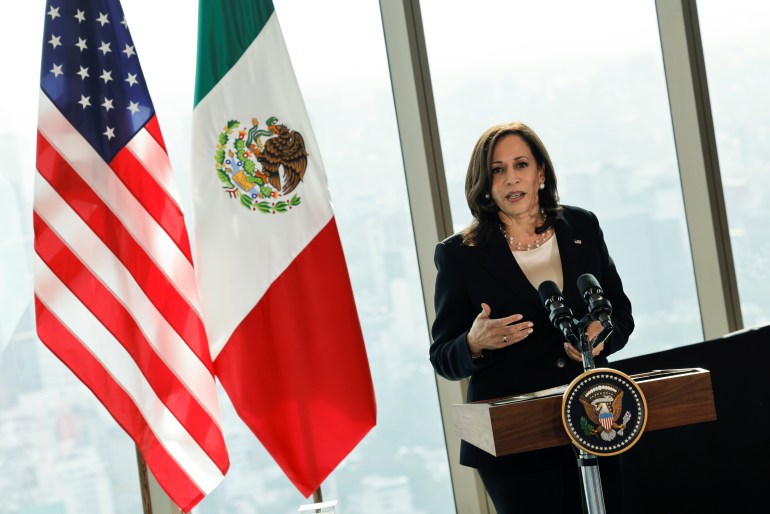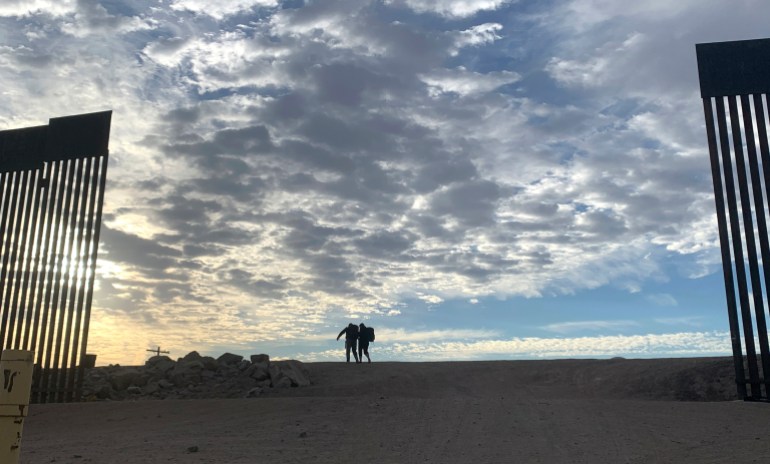Migration at US-Mexico border still high, despite Biden’s efforts
More than 180,000 migrants crossed into the US border in May, a 20-year high and up slightly from last month.

The number of migrants arriving in the United States through its southern border with Mexico remained high during the month of May, despite sustained diplomatic efforts by the Biden administration to stem the surge.
According to statistics published by the US Customs and Border Protection (CBP), 180,034 people were apprehended along the US-Mexico border in May, up slightly from 178,622 the previous month.
Keep reading
list of 3 itemsBiden administration ramps up diplomacy to stem migration
US VP Harris in Mexico, meets Lopez Obrador for migration talks
The number of children travelling alone dropped, however, to 10,765 according to the figures, from 13,940 in April. The numbers showed a significant decrease from the all-time high figure of 18,951 in March.
In May, CBP encountered more than 180,000 persons attempting entry along the SW border. This total represents a 1% increase over April.
Press release: https://t.co/IoniQDIuHT
Enforcement stats: https://t.co/AcdShCXjDS
SW Land Border Encounters: https://t.co/i3vbVkLjpB pic.twitter.com/ATyXFDOe5T— CBP (@CBP) June 9, 2021
The statistics released on Wednesday were the highest in 20 years and come on the heels of Vice President Kamala Harris’s diplomatic trip to Guatemala and Mexico aimed at finding ways to reduce migration from Central America.
On Monday, she delivered a blunt message from Guatemala to those thinking of making the journey north saying: “Do not come, do not come.”
“If you come to our border you will be turned back,” Harris warned.
The administration of President Joe Biden, which took office in January has continued to expel the majority of migrants arriving at the US-Mexico border through the use of a health order that cites the pandemic, put in place by former President Donald Trump last year.
According to the statistics, CBP expelled 112,302 people under “Title 42” during the month of May. The Biden administration has exempt unaccompanied minors from Title 42 expulsions and has permitted them to claim asylum in the US.

Biden’s Republican rivals accuse him of causing a rush to the border by exempting minors from expulsions, and reversing Trump’s other anti-immigration policies.
Immigration advocates have blasted Biden’s continued use of Title 42 expulsions, arguing that it violates US refugee law and is not based on scientific facts.
The Biden administration has also sought to discourage migration from the Northern Triangle – Honduras, El Salvador and Honduras – where the bulk of migrants come from, by tackling the so-called “root causes” of their flight.
Biden administration officials say people are less likely to leave their country when they have work and educational opportunities, when cities are safe and citizens trust their governments.
Central American countries are among the poorest in the region and suffer from endemic poverty, rampant gang violence and chronic corruption.
In recent years, Guatemala, Honduras and El Salvador have also been slammed by record storms that left millions in need of aid.
So far, the US has pledged $4bn to boost development in Central America and $310m in humanitarian assistance.

In Guatemala, Harris announced several new commitments to combat drug trafficking, people smuggling, and corruption.
But experts say it could take months or even years for such projects to take effect. On Tuesday, Harris signed a memorandum of understanding with Mexico that includes a commitment to strengthening security and development cooperation aimed at reducing migration.
On Thursday, the Department of Homeland Security (DHS) announced that Homeland Security Secretary Alejandro Mayorkas will travel to Mexico on June 14 and 15 to meet government officials.